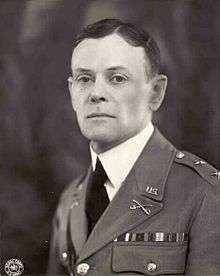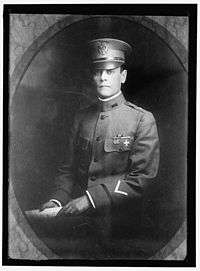Guy Henry (equestrian)
Major General Guy Vernor Henry Jr. (January 28, 1875 – November 29, 1967) was a senior officer in the United States Army and a noted horse rider who competed for the United States in the 1912 Summer Olympics.
Guy Vernor Henry Jr. | |
|---|---|
 | |
| Born | January 28, 1875 Fort Robinson, Nebraska |
| Died | November 29, 1967 (aged 92) Wenatchee, Washington |
| Buried | |
| Allegiance | United States |
| Service/ | United States Army |
| Years of service | 1898–1939 1941–1947 |
| Rank | Major General |
| Commands held | United States Army Cavalry School Fort Riley Fort Myer 7th Cavalry Brigade 3rd Cavalry Regiment |
| Battles/wars | Spanish–American War
World War I World War II |
| Awards | Army Distinguished Service Medal (2) Silver Star Legion of Honour (France) Companion of the Order of the Bath (United Kingdom) |
| Relations | Guy V. Henry (father) |
| Other work | Olympic equestrian |
| Medal record | ||
|---|---|---|
| Equestrian | ||
| Representing the | ||
| Olympic Games | ||
| 1912 Stockholm | Team eventing | |
Early life

Guy V. Henry, Jr. was born into the military life. Son of Guy Vernor Henry, he went on to graduate from the United States Military Academy at West Point in 1898,[1] and distinguished his military career by earning the Silver Star in 1899 during the Spanish–American War.[1]
Henry went on to study at the French Cavalry School in Saumur and used the knowledge he gained there to change the treatment and training of United States Cavalry horses. This included starting horses not by "breaking" them using the traditional western methods, but by training them on the longe, then slowly teaching them to accept the weight of a human on their back. He also brought dressage methods from both the French and German schools, with a great deal of influence from Baucher, and as senior instructor of equitation at the Mounted Service School at Fort Riley he insisted in teaching new recruits to properly use the aids and promoted the European methods. Henry helped to institute the high level of horsemanship at Fort Riley, helping to develop farrier and veterinary programs which were to become required courses for cavalry lieutenants. He also got rid of the harsh curb bit used by the Cavalry, known as the Shoemaker bit, and replaced it with either the snaffle bit or the double bridle.
Olympic equestrian career
Henry competed in all three Olympic equestrian disciplines – dressage, eventing, and show jumping – for the United States during his years in the army. His most distinguished Olympic results occurred at the 1912 Olympic Games in Stockholm, where he won the bronze medal in the team eventing competition, finished 11th in the individual event, 4th in the team jumping competition, and 13th in the individual dressage competition, riding Chiswell.
Henry later served at Chef dÉquipe for the United States Teams from 1936 to 1948, was chairman on the Olympic Equestrian Committee from 1930 to 1960, and director of equestrian events at the 1932 Summer Olympics in Los Angeles.
Other achievements
- Commandant of Cadets at West Point (1916–1918)[2]
- Commander of Fort Myer, Virginia (1927–1930)[3]
- Succeeded Herbert B. Crosby as Chief of Cavalry, United States Army (1930–1934)[2]
- Commandant of the US Army Cavalry School and Commander of Fort Riley (1935–1938)[2]
- Commander of the Seventh Corps Area (1838-1939)[4]
- Chairman of the US section of the Permanent Joint Defense Board with Canada (1948–1954)[2]
- Judge at horse shows at the international level
- Director of the US Equestrian Team
- Director of the American Horse Shows Association
- Director of New York's National Horse Show Association
- President of the Fédération Équestre Internationale, the only American to be placed in that position (1931–1935)
Decorations
| Army Distinguished Service Medal (w/oak leaf cluster)[5] | |
| Silver Star[5] | |
| Spanish War Service Medal | |
| Philippine Campaign Medal | |
| Army of Puerto Rican Occupation Medal | |
| World War I Victory Medal | |
| World War II Victory Medal | |
| American Defense Service Medal | |
| American Campaign Medal | |
| European-African-Middle Eastern Campaign Medal with two campaign stars | |
| Chevalier of the Legion of Honour | |
| Order of the Bath |
Footnotes
- "Gen. Guy V. Henry Is Dead" (PDF). The New York Times. 1899-10-28. Retrieved 2009-04-12.
- Davis, Jr., Henry Blaine (1998). Generals in Khaki. Raleigh, NC: Pentland Press, Inc. p. 175. ISBN 1571970886.
- Images of America - Fort Myer
- Clay, Steven E. (2010). US Army Order of Battle 1919–1941, Vol. 1: The Arms: Major Commands and Infantry Organizations (PDF). Fort Leavenworth, Kansas: Combat Studies Institute Press.
- "Valor awards for Guy Vernor Henry , Jr".
External links
- "Guy Henry". Olympics Statistics and History Database. databaseOlympics.com. Archived from the original on September 30, 2007. Retrieved December 30, 2008.
- "Guy Vernor Henry, Jr". Arlington National Cemetery Website. Retrieved December 30, 2008.
- Guy Vernor Henry Jr at Find a Grave